In 1914, the government of New York City took ownership of a Manhattan apartment building belonging to one David Hess. The city used a legal power called eminent domain, allowing governments to seize private property for public use — in this case they wanted to expand the subway system. Hess fought them and lost, and when all was said and done, his building was torn down, and he was left with a triangle shaped piece of property. It was about the size and shape of a large slice of pizza.
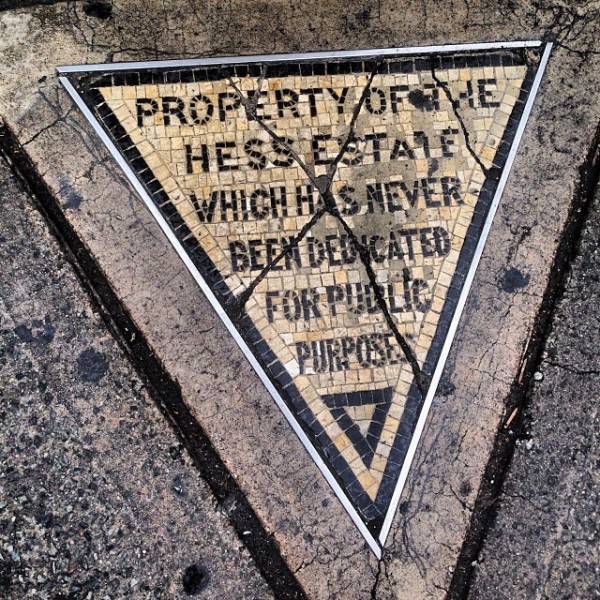
Later, the city tried to get him to donate his pizza-shaped property so that they could build a sidewalk. He refused again. They built the sidewalk anyway, and in the middle of the sidewalk is Hess’s triangle, with a tile mosaic that reads: “Property of the Hess Estate Which Has Never Been Dedicated For Public Purposes.”
People like David Hess, who refuse to sell their properties, are called holdouts. Eminent domain generally only comes into play when the government wants private property for public use (though there have been some exceptions). If it’s a private development that wants your place and you refuse to sell, there’s often not much they can do. In China, where there’s been development boom in recent years, they call their holdout houses “nail houses.”
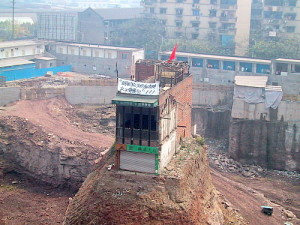
Around 2005, a Seattle neighborhood called Ballard started to see unprecedented growth. Condominiums and apartment buildings were sprouting up all over in a community which had previously been made up of mostly single family homes and small businesses. Around this time, developers offered an elderly woman named Edith Macefield $750,000 dollars for her small house, which was appraised at around $120,000. They wanted to build a shopping mall on the block where Macefield had lived for the last 50 years.
Macefield turned down the money. Developers went forward with the shopping mall anyway. The mall enveloped her house on three sides.
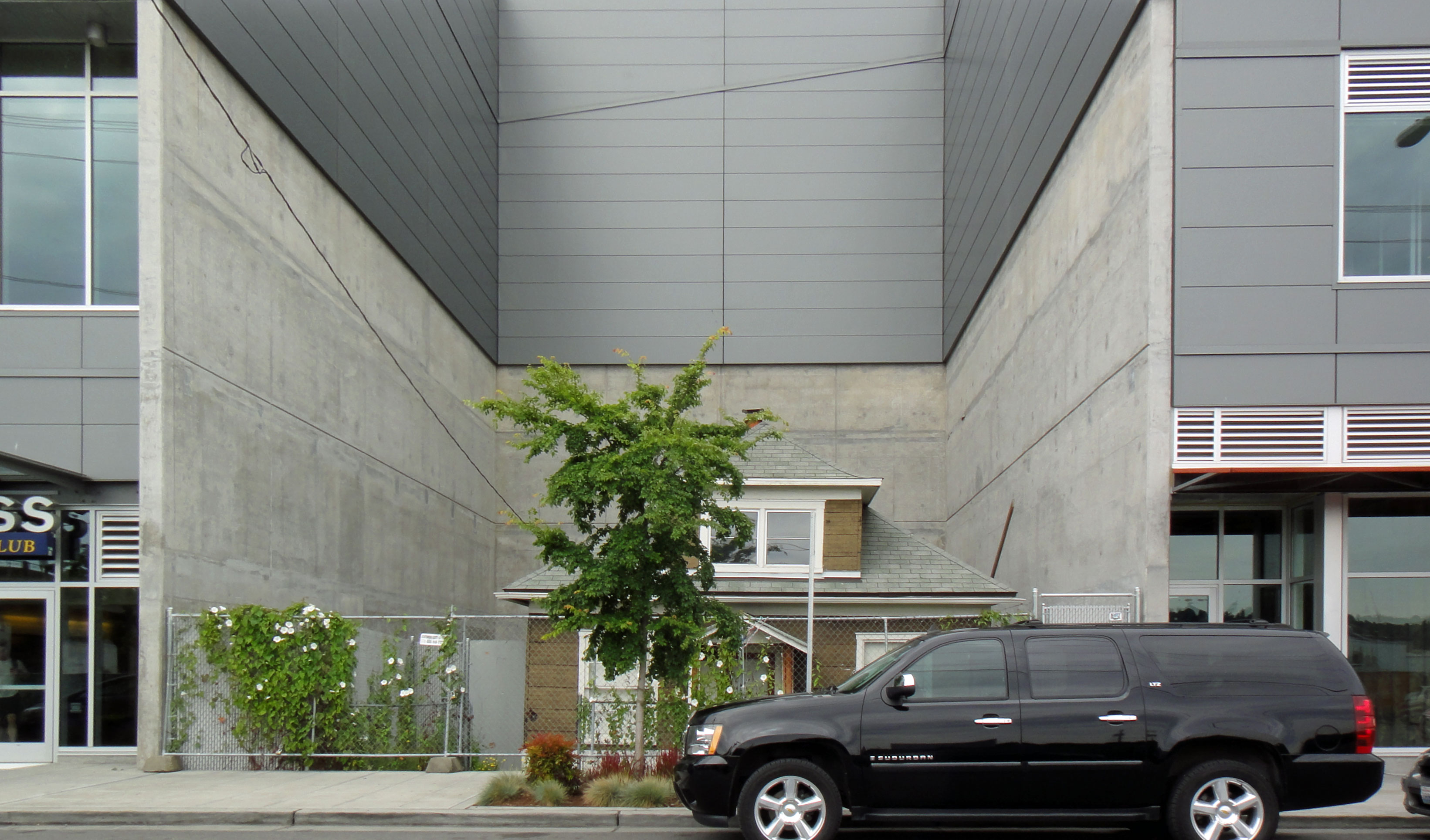
The architects designed the building in such a way that if Macefield ever decided to move, they could easily incorporate the space where her had been into the building. The developers eventually increased their offer to $1,000,000, also offering to find her a similar home somewhere else, and pay for a home health-care provider.
Again, Edith Macefield turned them down.

The press loved Edith Macefield’s “David and Goliath” story of a single old woman pitted against some the big, bad developers. But while the press was clamoring to talk to Macefield, she wanted nothing to do with talking to them (as evidenced in this CBS segment).
Slowly, Macefield warmed to some of the construction workers on the project, especially Barry Martin, the project superintendent who would check in on her occasionally and drop off business cards, telling her to call if she needed anything.
She eventually asked Martin to take her to a hair appointment.
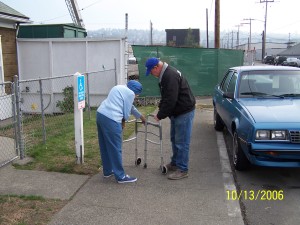
Soon thereafter, Barry Martin began taking Edith Macefield to all of her appointments — and then, because it was easier to coordinate with his schedule, he started making them.
Spending all of this time together, Martin got to know Macefield well. He learned that she was not upset about the way her community was changing. She was not even mad about the mall they were building more or less on top of her house. On the contrary, she seemed happy to have the company.
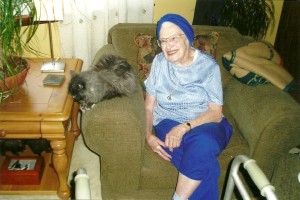
Macefield was an avid reader and loved to talk about books, listen to old music (a lot of opera and big-band music, according to Martin) and watch old movies. She was also a writer. Her longest piece was a 1,138-page work of fiction entitled Where Yesterday Began. She paid to have the book published in 1994 under the pen name “Domilini.”

As Martin got to know Macefield, the old woman told him stories about her past that were so incredible he found them hard to believe. For example, she said that she had been a spy for the British during World War II, and that was captured spying and spent time in the German concentration camp of Dachau.
She also said she’d taken care of a number of war orphans in England after the war with her then-husband James Macefield. To top it all off, she also claimed that Benny Goodman was her cousin and that she had played music with Tommy and Jimmy Dorsey (Macefield played both saxophone and clarinet).
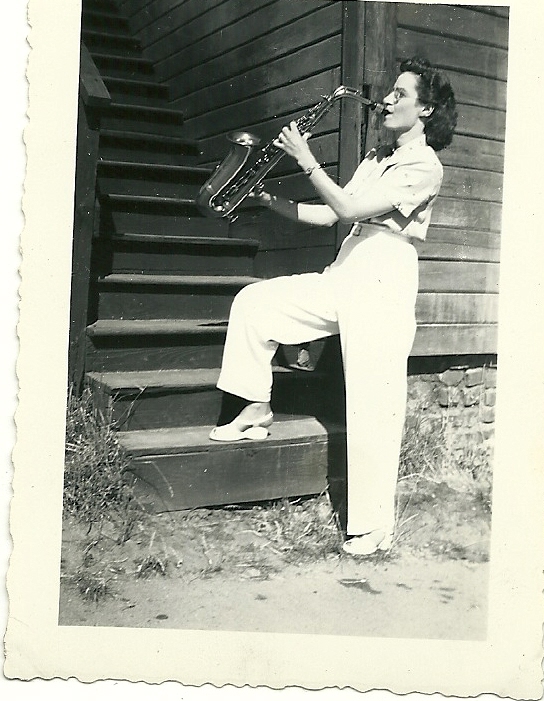
Barry Martin eventually became Edith Macefield’s main care-giver. He make most of her meals, visited with her on weekends and even attended to her in the middle of the night if she called and said she needed him. She finally agreed to a live-in nurse when she was diagnosed with pancreatic cancer. Even then, Martin had her power of attorney — she put him in charge of her final decisions.
Edith Macefield died in her house on June 15, 2008, at the age of 86.
She left her house to Barry Martin — the construction superintendent who became her friend while simultaneously sandwiching her house between a Trader Joe’s and an LA Fitness.
After she died, Martin began packing up Macefield’s house and looking for things that would confirm the crazy stories she had told him about her past. He never found anything about her escaping Dachau or caring for any war orphans. But he did find a Benny Goodman record with a written inscription that said “To my cousin Edith, with love, Benny.” He also found the below correspondence:
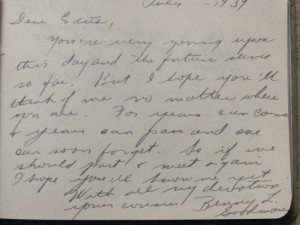
After people found out that Edith Macefield had left her house to Barry Martin, there were some who called him an opportunist. Ultimately it’s hard for anyone other than Martin to know what his motivations were, but a few healthcare workers who took care of Mrs. Macefield before she died also had a very high opinion of him. They said that he was there every day when no one else was and that he seemed to care deeply for Macefield.
Martin eventually sold Edith Macefield’s house to an investor who had various plans for it, none of which have materialized, and recently that same investor asked Martin if he’d be interested in buying it back.
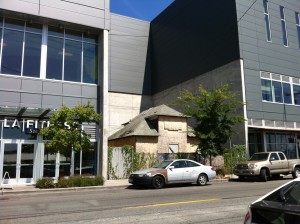
The house is all boarded up now, and no one is sure what will happen to it, which is sad to some people but Martin says that Macefield didn’t care what happened to the house after she died — that she never really cared about the bigger story that the outside world had created about her. She had her own personal reasons for staying in her house and they had nothing to do with that narrative.

Whatever her reasons were for doing it, she stood her ground. And she became a symbol, whether she wanted to or not. There’s even a tattoo shop in Seattle that does a special tattoo to honor the legacy of Edith Macefield. It is a picture of her little house, and underneath it — the word “Steadfast”.



Comments (41)
Share
Someone needs to make that little plot into a park with a PLAQUE telling Ms. Macefield’s story.
Here’s one in Portland. http://www.oregonlive.com/portland/index.ssf/2011/06/in_downtown_portland_a_lawyer.html
you left out that on May 26, 2009, Disney publicists attached balloons to the roof of Macefield’s house, as a promotional tie-in to their film Up, in which an aging widower’s home is similarly surrounded by looming development.
Clearly, the Hess Triangle is NOT a Thomasson.
As a former Seattleite, I appreciated the details that filled in this story. Here is another one from rapidly developing Ballard that is also pretty interesting: an historic boarded up Denny’s building that improbably made it onto the city’s landmarks preservation list (at the wrongheaded behest of the developer) shortly before it was demolished anyway, at which point the rubble-strewn lot sat fenced and vacant for years, a victim of the recession. The site is now an apartment building. http://www.historicseattle.org/advocacy/mannings.aspx
The one house that shares the block with the Oakland (CA) Children’s Hospital parking structure is a holdout house.
Honda headquarters in Torrance, CA had a crappy-looking auto repair shop in front of it for YEARS because the owner refused to sell.
I admired Edith’s dedication to her home, which should be more important than simply money. What doesn’t often get mentioned in this story is that for several years before construction began on the development, Edith’s house was the only one left standing on the entire block, with the rest of it being gravel and dirt. I, for one, couldn’t understand why someone would want to live on a desolate city block like that, but Edith was a holdout long before development was planned.
The 109 department store at Shibuya Crossing in Tokyo was redesigned to go around _and over_ a restaurant that held out for years and years (you can’t see it in the photo but there’s a couple feet of clearance on all sides. It would be a much nicer story if the restaurant in question wasn’t a whale-meat restaurant.
http://1.bp.blogspot.com/-vw1zHZUBkxQ/U8fHezICF8I/AAAAAAAAxFY/nQ_nuR9lPyM/s1600/shibuya071714_07.jpg
I would love to add another intriguing holdout. It’s called Mary’s Place and it’s enveloped by Providence Sacred Heart Medical Center in Spokane, WA. I would love to hear your take on that story. It’s really very interesting.
the developer had a really good idea actually. its sad it never got preserved
I really urge holdouts to carefully reconsider their position. Often their actions block their neighbours from improving their lives. For example, see this documentary:
http://english.cntv.cn/2014/07/19/VIDE1405753920238884.shtml
My first exposure to the holdout was from Virginia Lee Burton: http://en.wikipedia.org/wiki/The_Little_House
Yes! I was reminded of “The Little House” too while listening to this story. One of my favorite children’s books.
I live in Ballard and saw that building go up–in fact a friend of mine is an architect who worked on the project. And not to quibble, but I wouldn’t call it a mall, precisely.
Ballard has changed so much and continues to do so, much to many residents’ chagrin. For the most part, the density is happening where it should be–on arterials near transit lines. What is unfortunate is the trend of single family homes being torn down and replaced with a new single family home that maximizes allowable lot coverage and building height and dwarfs the smaller scale homes adjacent.
Santa Monica has interesting houses here and there that look charmingly out of place next to large developments. There was a holdout next to Crossroads school for a long time, though they finally sold to the school. There was another holdout among the houses along Pearl St between 20th and 17th south of Santa Monica College, though that family finally sold too (not sure if that’s really considered a “holdout” since the school is keeping their house appearance despite using them as offices). There are 3 cool little houses south of SM Blvd on 23rd, surrounded by 2-story apartment buildings, a business, and a big medical building parking lot. Don’t know the story on those but they must be holdouts. A tiny duplex on 4th just north of Wilshire is another trippy looking property surrounded by big multi-story properties.
I like the spirit of defiance with the holdouts but I’m baffled how they’re able to. I would think some bribe money to the right people and they’ll use eminent domain on the developer’s behalf. How can there be holdouts in China? Their govt would kick you out without thinking twice, I would think. How did the New York guy lose everything but keep a pizza-sized piece of property–why didn’t they just take it all at that point?
Canada Customs in the town of Fort Erie decided to build a bigger place to house not only Customs business but also several brokerages. They bought up several homes near the corner of Queen and Niagara but one family refused to sell. Every trucker who has to go inside to see a broker or to have a load inspected walks along the back fence line of this property after having driven their truck along the one side of the property. Check out 42.908990, -78.909868 on Google Maps to see it.
A famous Atlantic City holdout story recently ended (or started a new chapter).
http://is.gd/wvOIwT
Home owned by Trump holdout auctioned for $530,000
Atlantic City homeowner fought developers for decades
I have no verification but the story goes that a similar property war took place in Toronto Canada between a home owner and ESSO—I do know that the rumored house in question stood alone surrounded by ESSO corporate headquarters parking lot throughout 3 decades
The old Sears store in St. Joseph, Mo. had a house which was surrounded by the parking lot. This was in the 60’s. Don’t know if it is still there.
This is going to happen in San Francisco on the corner of 1st and Mission st. Diagonal from the Sales Force tower. Demolition construction has not begun but there is a small unit there that refuses to sell and the developer decided to build a 900′ tower around it. They still have time to sell.
I just loved this story…how a stranger reached out to her and ended up her closest friend and was blessed because of it.
wow found myself legitimately crying listening to this episode. so powerful.
My favorites involved Macy’s in New York City: http://placesnomore.wordpress.com/2012/08/05/sendeksandmacys/ and http://ephemeralnewyork.wordpress.com/2011/03/03/the-tiny-holdout-building-in-the-middle-of-macys/
Got most of these beat. If you lived in NYC in the 60s you knew about this holdout. Was also an aged woman living alone that did not want to sell to the mall development co. (for a Macys in this case. She turned down 200k back then, which was a huge amount of money. See:
http://placesnomore.wordpress.com/2012/08/05/sendeksandmacys/
This reminds me of the movie Batteries Not Included: http://onthesetofnewyork.com/batteriesnotincluded.html
It looks to me like the architects of the mall took design hints from the Crocker Spite Fence
http://www.sparkletack.com/2007/02/21/the-crocker-spite-fence/
Good heavens, now all I can think of is reading Where Yesterday Began. Someone needs to hunt that book down and share it with the world.
I grew up in West Seattle and always knew of Ballard as where many of my ancestors came from, Norwegian stock. My mother was born in the same era and what you described in Mrs. Macefield is mirrored in my mother. Her determination to remain where she was is exactly something people of that era would do. My own mother always thrived when she had independence. I was especially delighted by the first trip she took with the foreman…..to get her hair done! I live in Asia now and did not know of the story till your podcast. I was so delighted to hear that Mrs. Macefield’s last days were spent in the company of someone who cared for her well being. I hope followers of Roman’s stories will use this as an inspiration to spend time with family or neighbors who come from another era. I know Mr. Martin is glad he did. The stories Mrs. Macefield shared with him must be great treasures. Glad he shared them with us.
If I were David Hess I think I’d put up a fence around my property – just to make a point!
In Amsterdam we have a similar kind of thing in opposite to the Central Station. I don’t know the exact story but a book has been written about it and a film is in the making.
Around 1885 a big invester wanted to build a large hotel opposite to the, then under construction, Central Station. He had to buy out 10 houses but one of them refused. You can still see it today, in the facade of the Hotel. There are two small houses build around by the hotel.
here is a photo:
http://www.panoramio.com/photo/49794120
With kind regards,
Bas from Amsterdam
The Macefield House in Seattle’s Ballard neighborhood is slated for auction in March 2015. There is an active Facebook page for those interested at: https://www.facebook.com/macefieldhouse
https://homes.yahoo.com/blogs/spaces/edith-macefield-house-164539319.html
It went up for auction and nobody bid on it… Too bad.
http://m.seattlepi.com/local/article/Ballard-Up-house-attracts-no-bids-at-auction-6132517.php
Aug 2015 update: The house will be moved to Orcas Island (one of the San Juan islands in Puget Sound if the non-profit which won it can raise $200K for the move. http://www.seattletimes.com/seattle-news/up-house-could-move-by-barge-to-orcas-island/
Griffith Stadium in DC had a holdout in center field. http://i.imgur.com/CBQzeNU.png
September 2015: Edith’s house needs help. There is a Kickstarter to try to raise money to save it from demolition in the next couple of weeks. I am not affiliated with the project–I’m just a big fan of Edith’s. Here’s the link. Please help. http://kck.st/1M3aR4o
Loved this! Thanks for sharing. I am new to your site and podcasts and am enjoying them immensely!
This is the kind of episode that keeps me coming back for more.
Absolutely admire her for standing up for what she believes in! Great post!
Great job
Kortingscodes kunnen je helpen om het on-line kleding kopen nog
leuker, goedkoper te maken.